Related Research Articles
A comic strip is a sequence of cartoons, arranged in interrelated panels to display brief humor or form a narrative, often serialized, with text in balloons and captions. Traditionally, throughout the 20th and into the 21st century, these have been published in newspapers and magazines, with daily horizontal strips printed in black-and-white in newspapers, while Sunday papers offered longer sequences in special color comics sections. With the advent of the internet, online comic strips began to appear as webcomics.

A cartoon is a type of visual art that is typically drawn, frequently animated, in an unrealistic or semi-realistic style. The specific meaning has evolved, but the modern usage usually refers to either: an image or series of images intended for satire, caricature, or humor; or a motion picture that relies on a sequence of illustrations for its animation. Someone who creates cartoons in the first sense is called a cartoonist, and in the second sense they are usually called an animator.

Print syndication distributes news articles, columns, political cartoons, comic strips and other features to newspapers, magazines and websites. The syndicates offer reprint rights and grant permissions to other parties for republishing content of which they own and/or represent copyrights. Other terms for the service include a newspaper syndicate, a press syndicate, and a feature syndicate.
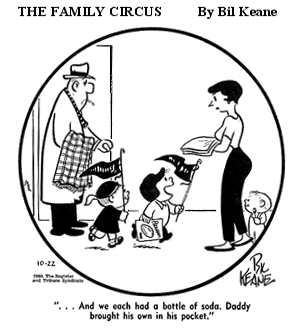
The Family Circus is a syndicated comic strip created by cartoonist Bil Keane and, since Keane's death in 2011, is written, inked and rendered (colored) by his son Jeff Keane. The strip generally uses a single captioned panel with a round border, hence the original name of the series, which was changed following objections from the magazine Family Circle. The series debuted on February 29, 1960 and has been in continuous production ever since. According to publisher King Features Syndicate, it is the most widely syndicated cartoon panel in the world, appearing in 1,500 newspapers. Compilations of Family Circus comic strips have sold more than 13 million copies worldwide.

Brenda Starr, Reporter is a comic strip about a glamorous, adventurous reporter. It was created in 1940 by Dale Messick for the Chicago Tribune Syndicate, and continued by others until 2011.

King Features Syndicate, Inc. is an American content distribution and animation studio, consumer product licensing and print syndication company owned by Hearst Communications that distributes about 150 comic strips, newspaper columns, editorial cartoons, puzzles, and games to nearly 5,000 newspapers worldwide. King Features Syndicate also produces intellectual properties, develops new content and franchises, like The Cuphead Show!, which it produced with Netflix, and licenses its classic characters and properties.
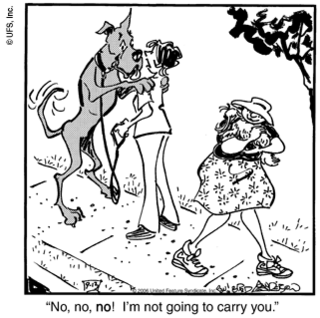
Marmaduke is a newspaper comic strip revolving around the Winslow family and their Great Dane, Marmaduke, drawn by Brad Anderson from June 1954 to 2015.
A daily strip is a newspaper comic strip format, appearing on weekdays, Monday through Saturday, as contrasted with a Sunday strip, which typically only appears on Sundays. They typically are smaller, 3-4 grids compared to the full page Sunday strip and are black and white.

A panel is an individual frame, or single drawing, in the multiple-panel sequence of a comic strip or comic book, as well as a graphic novel. A panel consists of a single drawing depicting a frozen moment. When multiple panels are present, they are often, though not always, separated by a short amount of space called a gutter.

Sherrill David "Jerry" Robinson was an American comic book artist known for his work on DC Comics' Batman line of comics during the 1940s. He is best known as the co-creator of Robin and the Joker and for his work on behalf of creators' rights.

Skippy is an American comic strip written and drawn by Percy Crosby that was published from 1923 to 1945. A highly popular, acclaimed and influential feature about rambunctious fifth-grader Skippy Skinner, his friends and his enemies, it was adapted into movies, a novel and a radio show. It was commemorated on a 1997 U.S. Postal Service stamp and was the basis for a wide range of merchandising—although perhaps the most well-known product bearing the Skippy name, Skippy peanut butter, used the name without Crosby's authorization, leading to a protracted trademark conflict.
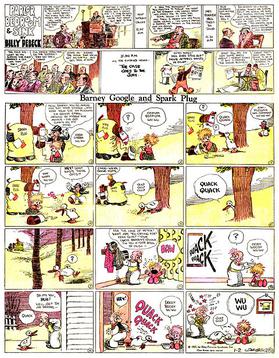
The Sunday comics or Sunday strip is the comic strip section carried in most western newspapers. Compared to weekday comics, Sunday comics tend to be full pages and are in color. Many newspaper readers called this section the Sunday funnies, the funny papers or simply the funnies.
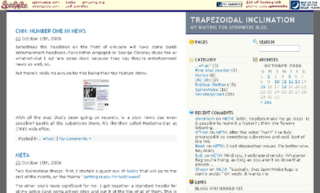
SpinnWebe was the personal website of Greg Galcik, also known as "spinn". It gathered the most fame as the home of the Dysfunctional Family Circus, which ran in the late 1990s. The site also included a number of Galcik's other projects, which generally had interactive humor as the unifying theme; in this respect, it anticipated the development of later sites such as Fark and Something Awful. Spinnwebe is a German word for "spider web".
A comic strip syndicate functions as an agent for cartoonists and comic strip creators, placing the cartoons and strips in as many newspapers as possible on behalf of the artist. A syndicate can annually receive thousands of submissions, from which only two or three might be selected for representation. In some cases, the work will be owned by the syndicate as opposed to the creator. The Guinness World Record for the world's most syndicated strip belongs to Jim Davis' Garfield, which at that point (2002) appeared in 2,570 newspapers, with 263 million readers worldwide.
Percy Lee Crosby was an American author, illustrator and cartoonist best known for his comic strip Skippy. Adapted into movies, a novel and a radio show, Crosby's creation was commemorated on a 1997 U.S. Postal Service stamp. An inspiration for Charles Schulz's Peanuts, the strip is regarded by comics historian Maurice Horn as a "classic... which innovated a number of sophisticated and refined touches used later by Charles Schulz and Bill Watterson." Humorist Corey Ford, writing in Vanity Fair, praised the strip as "America's most important contribution to humor of the century".
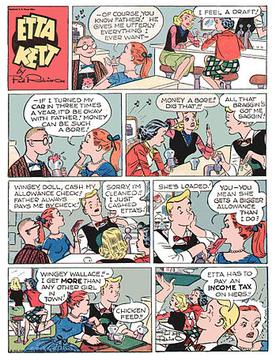
Etta Kett is a long-running comic strip created by Paul Robinson, which ran from December 7, 1925 to November 9, 1974.

Freckles and his Friends is an American comic strip set in the peaceful small town of Shadyside where young Freckles McGoosey and his friends lived. Although the long-running strip, created by Merrill Blosser, is remembered for its continuing storyline involving a group of teenagers, it originally featured a child at the age of six or seven in gag-a-day situations.
The Dinette Set is a single-panel newspaper comic by artist Julie Larson. Set in the fictional Midwestern suburban community of Crustwood, the comic satirized middle-class culture; its main characters are 50-ish sisters Verla Darwin and Joy Penny. The comic poked fun at middle-class perceptions of common, everyday issues.
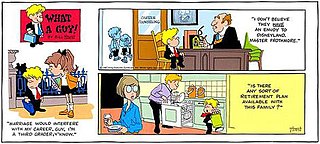
What a Guy! is an American comic strip created by Bill Hoest and Bunny Hoest, the team responsible for The Lockhorns and Agatha Crumm. It began in March 1987, just over a year before Hoest's death in 1988.

McClure Newspaper Syndicate, the first American newspaper syndicate, introduced many American and British writers to the masses. Launched in 1884 by publisher Samuel S. McClure, it was the first successful company of its kind. It turned the marketing of comic strips, columns, book serials and other editorial matter into a large industry, and a century later, 300 syndicates were distributing 10,000 features with combined sales of $100 million a year.
References
- ↑ Library.syr.edu
- ↑ Jerry Robinson Papers 1953–2009 Syracuse University, November 19, 2010. Retrieved November 30, 2010
- ↑ Worldcat.org